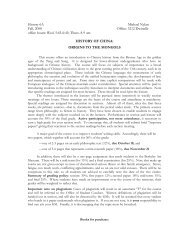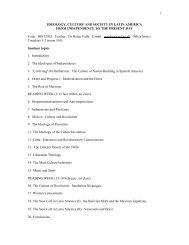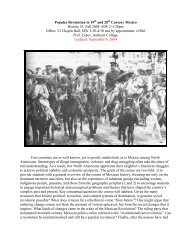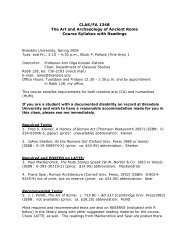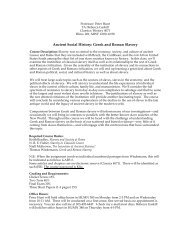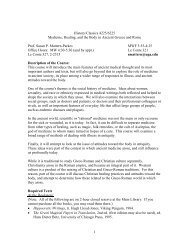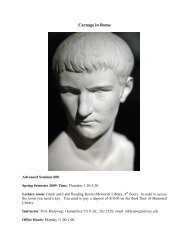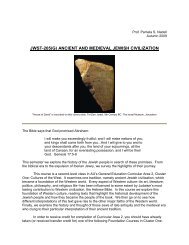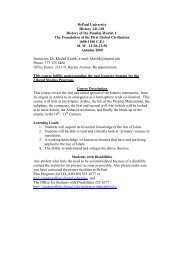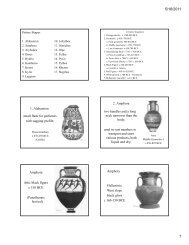the History of Psychiatry, 1750-1950 - Mister Dans Home Page
the History of Psychiatry, 1750-1950 - Mister Dans Home Page
the History of Psychiatry, 1750-1950 - Mister Dans Home Page
You also want an ePaper? Increase the reach of your titles
YUMPU automatically turns print PDFs into web optimized ePapers that Google loves.
HS1797<br />
Madness, Madmen and <strong>the</strong> Asylum<br />
The <strong>History</strong> <strong>of</strong> <strong>Psychiatry</strong>, <strong>1750</strong>-<strong>1950</strong><br />
MODULE HANDBOOK<br />
2004/5<br />
Contents<br />
Overview<br />
Statement <strong>of</strong> Aims and Learning Outcomes<br />
Outline <strong>of</strong> Teaching<br />
Statement <strong>of</strong> Teaching and Learning Methods<br />
Schedule <strong>of</strong> Assessment<br />
Specimen Examination Paper<br />
Suggestions for Critical Reviews<br />
Assessed Essay Questions<br />
Guide to Lectures, Seminars and Document Sessions
OVERVIEW<br />
In <strong>the</strong> eighteenth century <strong>the</strong> ‘mad’ was <strong>of</strong>ten cast as animalistic, a brute devoid <strong>of</strong> sense. By <strong>the</strong><br />
mid-nineteenth century, madness had been institutionalised and had come to represent a loss <strong>of</strong><br />
reason something that could be returned to sanity by management. How had <strong>the</strong>se changes come<br />
about The module seeks to address this question and provide a broad overview <strong>of</strong> <strong>the</strong> history <strong>of</strong><br />
psychiatry from <strong>the</strong> beginning <strong>of</strong> state regulated asylums through to <strong>the</strong> introduction <strong>of</strong> physical<br />
treatments in <strong>the</strong> interwar period. It examines <strong>the</strong> rise <strong>of</strong> an institutional approach to mental<br />
disorder; how asylums evolved into ‘warehouses for <strong>the</strong> mad’; and how this shaped approaches to<br />
treatment. In doing so, <strong>the</strong> module analyses <strong>the</strong> reasons behind <strong>the</strong> growth <strong>of</strong> mental institutions<br />
and <strong>the</strong> legal arrangements for <strong>the</strong> management and treatment to explore how religion, class,<br />
gender, family and community defined mental disorder and its treatment. The module will go on to<br />
investigate how ideas about mental disorder changed in <strong>the</strong> twentieth century. It will examine <strong>the</strong><br />
role <strong>of</strong> doctors as <strong>the</strong>y evolved from ‘mad-doctors’ to psychiatrists, and look at <strong>the</strong> different ways <strong>of</strong><br />
classifying insanity alongside treatment regimes, changes in definitions, explanations and<br />
depictions <strong>of</strong> madness.<br />
RESEARCH-LED TEACHING<br />
This module arises out <strong>of</strong> a research project I was involved in after finishing my PhD. Working with<br />
<strong>the</strong> late Roy Porter on a multi-authored volume on <strong>the</strong> history <strong>of</strong> Bethlem – <strong>the</strong> first “asylum” in<br />
Britain – I was responsible for researching and writing <strong>the</strong> twentieth-century section. After two<br />
years <strong>of</strong> intensive research, a 700-page book was published that covered <strong>the</strong> history <strong>of</strong> Bethlem<br />
from 1247 to 1995. It addressed <strong>the</strong> hospital’s alto ego, Bedlam, looked at <strong>the</strong> patients admitted,<br />
<strong>the</strong> treatments used, and <strong>the</strong> hospital’s intimate relationship with <strong>the</strong> development <strong>of</strong> psychiatry.<br />
My work on <strong>the</strong> Bethlem project related to my previous research interests in medical charity and<br />
<strong>the</strong> pr<strong>of</strong>essionalisation <strong>of</strong> medicine as well as an interest in social control and twentieth-century<br />
treatments. Although my current research on diseased meat and <strong>the</strong> public’s health in Victorian<br />
and Edwardian Britain has moved away from madness, this module builds on <strong>the</strong> research carried<br />
out as part <strong>of</strong> <strong>the</strong> Bethlem project and on an ongoing interest in <strong>the</strong> history <strong>of</strong> psychiatry as well as<br />
my much broader interest in <strong>the</strong> history <strong>of</strong> medicine.<br />
AIMS OF MODULE<br />
(Aims define <strong>the</strong> broad purpose <strong>of</strong> <strong>the</strong> module)<br />
• To introduce students to <strong>the</strong> history <strong>of</strong> psychiatry in <strong>the</strong> period <strong>1750</strong> to <strong>1950</strong> to break with<br />
notions <strong>of</strong> a progressive evolution and contemporary assumptions;<br />
• To examine <strong>the</strong> rise <strong>of</strong> <strong>the</strong> asylum and <strong>the</strong> related historical debates, with particular reference to<br />
<strong>the</strong> impact <strong>of</strong> Foucault, Porter and Scull;<br />
• To investigate how madness was perceived, and how it reflected and contributed to social<br />
values on gender, deviancy and <strong>the</strong> role <strong>of</strong> <strong>the</strong> state;<br />
• To equip students with an appreciation <strong>of</strong> <strong>the</strong> social, religious and ideological forces that have<br />
influenced social and medical ideas <strong>of</strong> madness.<br />
LEARNING OUTCOMES<br />
At <strong>the</strong> end <strong>of</strong> <strong>the</strong> period <strong>of</strong> learning, <strong>the</strong> student will be expected to<br />
• analyse key <strong>the</strong>mes and issues that have influenced social and medical ideas <strong>of</strong> madness<br />
• discuss with reference to modern historical scholarship selected topics in <strong>the</strong> history <strong>of</strong><br />
psychiatry, such as <strong>the</strong> rise <strong>of</strong> <strong>the</strong> asylum, gender and madness, wrongful confinement,<br />
degeneration, psychoanalysis, shellshock, and physical treatments<br />
• to encourage students to evaluate critically <strong>the</strong> common assumptions found in historical<br />
writing on <strong>the</strong> topic<br />
<strong>Page</strong> 2 <strong>of</strong> 25
Knowledge and Understanding:<br />
• demonstrate a broad knowledge <strong>of</strong> <strong>the</strong> history <strong>of</strong> psychiatry between <strong>1750</strong> and <strong>1950</strong> and an<br />
understanding <strong>of</strong> <strong>the</strong> pertinent historical and historiographical ideas<br />
• demonstrate a familiarity with <strong>the</strong> main ideas, figures, and events in psychiatric history<br />
during <strong>the</strong> modern period in Britain within a conceptual framework which questions<br />
contemporary assumptions identify <strong>the</strong> main tenets <strong>of</strong> <strong>the</strong> social history <strong>of</strong> madness<br />
• demonstrate an understanding <strong>of</strong> a range <strong>of</strong> concepts/debates within <strong>the</strong> appropriate<br />
secondary literature<br />
• analyse key <strong>the</strong>mes in <strong>the</strong> history <strong>of</strong> psychiatry in <strong>the</strong> light <strong>of</strong> those ideas/frameworks<br />
Intellectual Skills:<br />
• identify <strong>the</strong> nature and scope <strong>of</strong> <strong>the</strong> issues raised in <strong>the</strong> history <strong>of</strong> psychiatry<br />
• summarise and appraise <strong>the</strong> relative merits and demerits <strong>of</strong> alternative views and<br />
interpretations in <strong>the</strong> history <strong>of</strong> psychiatry (in particularly notions <strong>of</strong> confinement, gender,<br />
pr<strong>of</strong>essionalisation and label madness) and evaluate <strong>the</strong>ir significance<br />
• identify problems, assess evidence, and reach conclusions consistent with <strong>the</strong>m<br />
• devise and sustain arguments about key topics in <strong>the</strong> history <strong>of</strong> psychiatry using ideas or<br />
techniques including post-structuralism, pr<strong>of</strong>essionalisation, gender, and institutionalisation<br />
• present, accurately, succinctly and lucidly, and in written or oral form <strong>the</strong>ir arguments in<br />
accordance with appropriate scholarly conventions<br />
Discipline Specific (including practical) Skills:<br />
• express <strong>the</strong>ir ideas and assessments on <strong>the</strong> history <strong>of</strong> psychiatry between <strong>1750</strong> and <strong>1950</strong><br />
• discuss in an informed manner <strong>the</strong> history <strong>of</strong> psychiatry<br />
• evaluate a range <strong>of</strong> arguments <strong>of</strong> alternative historical/historiographical interpretations<br />
appropriate to <strong>the</strong> study <strong>of</strong> <strong>the</strong> history <strong>of</strong> madness in <strong>the</strong> modern periods<br />
Transferable Skills:<br />
• communicate ideas and arguments effectively, whe<strong>the</strong>r in speech or in writing in an <br />
accurate, succinct and lucid manner<br />
• formulate and justify <strong>the</strong>ir own arguments and conclusions about a range <strong>of</strong> issues<br />
• demonstrate an ability to modify as well as to defend <strong>the</strong>ir own position<br />
• posses a range <strong>of</strong> information technology resources to assist with information retrieval<br />
• organise <strong>the</strong>ir own study methods and workload work as part <strong>of</strong> a team in seminar or<br />
tutorial discussions<br />
What are your expectations <strong>of</strong> <strong>the</strong> module<br />
<strong>Page</strong> 3 <strong>of</strong> 25
OUTLINE OF TEACHING<br />
2004: Semester One<br />
INTRODUCTION<br />
Week 1 Introduction Lecture 4 October<br />
BLOCK ONE: Viewing Madness<br />
Week 2 Bedlam Mad<br />
Lecture 11 October<br />
Seminar 13 October<br />
Week 3 Enlightened views <strong>of</strong> madness Lecture 18 October<br />
Week 4 Madness <strong>of</strong> George III Video 25 October<br />
Week 5 Madness <strong>of</strong> George III Seminar 1 November<br />
Week 6 Reading Week<br />
Week 7 Trade in Lunacy<br />
Lecture 15 November<br />
Seminar 17 November<br />
Week 8 Managing <strong>the</strong> Mad Lecture 22 November<br />
Week 9 Reforming <strong>the</strong> Asylum<br />
Lecture 29 November<br />
Seminar 1 December<br />
BLOCK TWO: The Asylum Age<br />
Week 10 Warehouses for <strong>the</strong> Insane Seminar 6 December<br />
Week 11 Gender and Madness<br />
Lecture 13 December<br />
Seminar 15 December<br />
Christmas Recess<br />
2005 :Semester Two<br />
Week 1 Wrongfully confined Lecture 31 January<br />
Week 2 Poor Law Lecture 7 February<br />
Seminar 9 February<br />
BLOCK THREE: Mind and Body<br />
Week 3 The rebirth <strong>of</strong> restraint Lecture 14 February<br />
Week 4 Notions <strong>of</strong> degeneracy Lecture 21 February<br />
Seminar 23 February<br />
Week 5 Reading Week<br />
Week 6 Freud and psychoanalysis Lecture 7 March<br />
Week 7 War and Shellshock Lecture 14 March<br />
Seminar 16 March<br />
Easter Recess<br />
Week 8 The Borderline Lecture 11 April<br />
Week 9 Physical Therapies Lecture 18 April<br />
Seminar 20 April<br />
BLOCK FOUR: Overview<br />
Week 10 Revision Session Seminar 25 April<br />
<strong>Page</strong> 4 <strong>of</strong> 25
TEACHING AND LEARNING METHODS<br />
This module will be taught in two-hour slots through a mixture <strong>of</strong> lectures and seminars.<br />
• The aim <strong>of</strong> <strong>the</strong> lectures (14) is not to provide comprehensive information on a particular<br />
topic. Ra<strong>the</strong>r <strong>the</strong>y are intended as an introduction to <strong>the</strong> salient features <strong>of</strong> major <strong>the</strong>mes<br />
and topics, to identify <strong>the</strong> key issues, and guide and focus reading. They aim to provide a<br />
basic framework for understanding and should <strong>the</strong>refore be thought <strong>of</strong> as useful starting<br />
points for fur<strong>the</strong>r discussion and work.<br />
• Seminars (12) concentrate more intensively on specific issues and provide <strong>the</strong> opportunity<br />
for fuller discussion <strong>of</strong> events / <strong>the</strong>mes / concepts / historiographical considerations that are<br />
central to <strong>the</strong> module. Seminars are linked to lectures. They are not intended to test your<br />
knowledge but to provide you with an opportunity to collectively enhance your<br />
understanding <strong>of</strong> a subject, to provide a forum for <strong>the</strong> expression <strong>of</strong> ideas, and to jointly<br />
explore <strong>the</strong>mes and arguments. Successful seminars depend upon a collective willingness<br />
to prepare thoroughly and to participate in discussion. It is important to ask questions, no<br />
matter how silly you think <strong>the</strong>y are; to raise issues that interest/confuse you; and discussion<br />
issues or <strong>the</strong>mes.<br />
• Video (1) on “The Madness <strong>of</strong> King George”<br />
• Revision Session (1) aims to provide an overview <strong>of</strong> <strong>the</strong> course.<br />
SCHEDULE OF ASSESSMENT<br />
You will be assessed by means <strong>of</strong> a combination <strong>of</strong> an assessed essay and an examination paper.<br />
You will also be required to submit a piece <strong>of</strong> non-assessed work.<br />
Un-assessed Work<br />
The non-assessed assignment must be at least 1,000 words long and should take <strong>the</strong> form <strong>of</strong> a<br />
book review or a critical survey. Suggestions can be found fur<strong>the</strong>r on in <strong>the</strong> module handbook but I<br />
am also happy for you to choose your own text(s). The review / survey must employ <strong>the</strong><br />
conventions <strong>of</strong> scholarly presentation and must be submitted in accordance with <strong>the</strong> procedures<br />
and dates as outlined in Information for all Students Taking Modules in <strong>History</strong> and/or Welsh<br />
<strong>History</strong> in Year 2. The non-assessed assignment provides an opportunity for a formative<br />
assessment. It <strong>of</strong>fers <strong>the</strong> chance for extensive feedback on your work. It is designed to help you<br />
and to highlight your strengths and weaknesses.<br />
Assessed Essay<br />
You must submit ONE assessed essay <strong>of</strong> not more than 2,000 words, which will contribute 25%<br />
<strong>of</strong> <strong>the</strong> final mark for <strong>the</strong> module. The essay is designed to give you <strong>the</strong> opportunity to demonstrate<br />
your ability to review evidence or <strong>the</strong> historiography, draw appropriate conclusions, and employ <strong>the</strong><br />
formal conventions <strong>of</strong> scholarly presentations. Please choose a question from one <strong>of</strong> <strong>the</strong> assessed<br />
essay topics. The assessed essay must be submitted in accordance with <strong>the</strong> procedures and<br />
dates as outlined in 'Information for all Students taking Modules in <strong>History</strong> and/or Welsh <strong>History</strong> in<br />
Year 2'.<br />
Written Examination<br />
In addition to <strong>the</strong> assessed essay, <strong>the</strong> module is examined by an unseen three-hour written paper,<br />
which will take place during <strong>the</strong> second assessment period (i.e. in May/June 2004). The<br />
examination counts for 75% <strong>of</strong> <strong>the</strong> final mark for this module. In deciding classification, equal<br />
weight is given to all final marks. A specimen examination paper in outlined below.<br />
NOTE: The 'Information for all Students taking Modules in <strong>History</strong> and/or Welsh <strong>History</strong> in Year 2'<br />
contains important information on essay writing which you should consult.<br />
<strong>Page</strong> 5 <strong>of</strong> 25
OUTLINE OF MODULE PROGRAMME<br />
You will see that <strong>the</strong>re are sessions every week on Monday, which will take place at 15.10 in<br />
Room X4.02, and fortnightly on Wednesday, which will take place at 10.00 in Room X4.02. The<br />
two week / one week regular pattern is adopted in order to allow for <strong>the</strong> 30 contact hours that a<br />
triple module comprises. The non-formal contact hour on alternate Wednesdays will be time<br />
available for you to consult me ei<strong>the</strong>r individually or in groups on any matters relating to this<br />
module, including discussing your written work and returning essays. You are not confined to<br />
coming to see me during this period only (see details <strong>of</strong> my <strong>of</strong>fice hours on p. 6), but it is <strong>the</strong>re for<br />
your use. I would also encourage you to take advantage <strong>of</strong> this room and time to meet and<br />
discuss informally among yourselves topics relating to this module.<br />
Duration: Three hours<br />
Answer THREE questions<br />
SPECIMEN EXAM PAPER<br />
You will be penalised if <strong>the</strong>re is substantial overlap between your examination answers and<br />
material already used in assessed coursework.<br />
1. Asses <strong>the</strong> role Bethlem played in <strong>the</strong> development <strong>of</strong> attitudes and policies towards madness<br />
before 1820.<br />
2. To what extent did <strong>the</strong> eighteenth century see a change in how <strong>the</strong> mad were viewed<br />
3. In what ways and by what means did George III’s treatment reflect ideas about moral<br />
management<br />
4. How different was “psychiatry for <strong>the</strong> rich” from “psychiatry for <strong>the</strong> poor” between <strong>1750</strong> and<br />
1850<br />
5. To what extent did psychiatry serve <strong>the</strong> interests <strong>of</strong> families more than <strong>the</strong> needs <strong>of</strong> <strong>the</strong> state in<br />
<strong>the</strong> eighteenth and nineteenth century<br />
6. “Women are more naturally prone to mental disorders than men”.<br />
statement reflect medical views <strong>of</strong> women and madness<br />
To what extent does this<br />
7. “Late-nineteenth century asylums were little more than warehouses for <strong>the</strong> insane”.<br />
Discuss.<br />
8. “Shellshock had a pr<strong>of</strong>ound impact on how madness was understood”.<br />
Discuss.<br />
9. Why did doctors so uncritically embrace physical <strong>the</strong>rapies in <strong>the</strong> treatment <strong>of</strong> mental illness<br />
between 1900 and <strong>1950</strong><br />
10. How far and how successfully did mad-doctors pr<strong>of</strong>essionalise <strong>the</strong>mselves between <strong>1750</strong> and<br />
<strong>1950</strong><br />
<strong>Page</strong> 6 <strong>of</strong> 25
SUGGESTIONS FOR CRITICAL REVIEWS<br />
1. Write a critical review <strong>of</strong> Andrew Scull’s Most Solitary <strong>of</strong> Afflictions<br />
2. Write a critical review <strong>of</strong> Michel Foucault’s Madness and Civilisation<br />
3. To what extent have historical interpretations <strong>of</strong> Bethlem changed<br />
4. To what extent has Roy Porter’s work changed attitudes to madness in <strong>the</strong> eighteenth century<br />
5. “The social history <strong>of</strong> asylums is a recent growth area in medical history”. Discuss<br />
ASSESSED ESSAY QUESTIONS<br />
Write an essay <strong>of</strong> not more than 2,000 words on one <strong>of</strong> <strong>the</strong> following questions:<br />
1. Was Bethlem Hospital as appalling as <strong>the</strong> ‘Bedlam’ portrayed by satirists and reformers in <strong>the</strong><br />
period 1700 to 1850<br />
2. To what extent did William Battie’s views reflect new attitudes to mental illness in <strong>the</strong> eighteenth<br />
century<br />
3. What does <strong>the</strong> treatment <strong>of</strong> George III tell us about <strong>the</strong> nature <strong>of</strong> English psychiatry at <strong>the</strong> end <strong>of</strong><br />
<strong>the</strong> eighteenth century<br />
4. Were eighteenth century private madhouses anything o<strong>the</strong>r than places to lock up troublesome<br />
people<br />
5. To what extent should moral <strong>the</strong>rapy be seen as primarily stemming from <strong>the</strong> work <strong>of</strong> <strong>the</strong> Tuke’s<br />
at <strong>the</strong> York Retreat<br />
6. ‘Madness in women was understood in terms <strong>of</strong> <strong>the</strong>ir bodies not <strong>the</strong>ir minds’.<br />
Discuss.<br />
7. Assess <strong>the</strong> role <strong>of</strong> <strong>the</strong> Poor Law in <strong>the</strong> treatment <strong>of</strong> <strong>the</strong> insane.<br />
8. To what extent did fears <strong>of</strong> degeneration provide a potent force in shaping <strong>the</strong> state’s response<br />
to mental illness between 1890 and 1939<br />
9. To what extent did <strong>the</strong> First World War mark a change in how madness was understood<br />
10. ‘ECT and lobotomies should be seen as nothing more than brutal and horrific treatments in <strong>the</strong><br />
history <strong>of</strong> psychiatry’. Discuss.<br />
CONTACT<br />
• Teaching sessions:<br />
MAIN:<br />
ALTERNATE:<br />
• Office Hours<br />
Monday, 15.10-16.00 in X4.02<br />
Wednesday, 10.00-10.50 in X4.02<br />
I generally operated an open door policy: if my door is open <strong>the</strong>n<br />
come in and I shall be happy to chat. If you prefer a more formal<br />
meeting, <strong>the</strong>n I shall always be in my <strong>of</strong>fice on Mondays before class<br />
from 10 to 11, and from 4 to 5 and on Wednesdays from 9 to 11.<br />
<strong>Page</strong> 7 <strong>of</strong> 25
If you want to make an “appointment” please drop by my <strong>of</strong>fice (Room 4.33, ext. 76103) or e-mail<br />
(WaddingtonK@Cardiff.ac.uk)<br />
GUIDE TO LECTURES, SEMINARS AND DOCUMENT SESSIONS<br />
Guidance for your reading for this module is broken down by lecture/seminar. For each lecture,<br />
seminar, and document session <strong>the</strong>re is an outline <strong>of</strong> <strong>the</strong> topic and a list <strong>of</strong> reading. Each week<br />
has a list <strong>of</strong> Key Texts or essential reading, all <strong>of</strong> which is kept in <strong>the</strong> central collection. Whilst I<br />
do not expect you to read all <strong>the</strong> key texts, you should at least tackle one. Each class also has<br />
additional reading. I have tried to be as comprehensive and include as many articles as possible.<br />
You should consult <strong>the</strong>se items for fur<strong>the</strong>r reading, especially for essays and examination<br />
preparation. I can always recommend more books/articles if you need <strong>the</strong>m. Where possible I<br />
have also included web resources, though you might also check out<br />
http://www.cf.ac.uk/hisar/people/kw/hom.html, which has some useful links, particularly to libraries,<br />
maps, and images (which always go down well in an essay).<br />
Please note that <strong>the</strong> many <strong>of</strong> <strong>the</strong> most important books for this module toge<strong>the</strong>r with <strong>the</strong><br />
documents and photocopies <strong>of</strong> important articles (i.e. those from Medical <strong>History</strong>, Social <strong>History</strong> <strong>of</strong><br />
Medicine (before 2000), and Bulletin <strong>of</strong> <strong>the</strong> <strong>History</strong> <strong>of</strong> Medicine) are in <strong>the</strong> central collection in <strong>the</strong><br />
Library. You can also access a large number <strong>of</strong> articles on <strong>the</strong> reading list through <strong>the</strong> electronic<br />
journals available through <strong>the</strong> University. Go to http://ejournals.cf.ac.uk/ and type in <strong>the</strong> journal<br />
name you are looking for. JSTOR ( http://www.jstor.org/ ) also <strong>of</strong>fers a large selection (see end for<br />
journals available).<br />
Lectures and seminars are accompanied by a number <strong>of</strong> questions which are intended to help<br />
guide your reading and to provide a starting point for seminar discussions. During seminars we will<br />
be brainstorming one or more questions (and sometimes documents) relevant to <strong>the</strong> topic <strong>of</strong> <strong>the</strong><br />
session. You will be expected both to lead and to contribute to seminar discussions. Harsh I<br />
know, but you will get more out <strong>of</strong> <strong>the</strong> sessions that way.<br />
I HOPE YOU ENJOY THE MODULE!<br />
Keir<br />
KEY TEXTS<br />
G. Berrios and Hugh Freeman (eds), 150 Years <strong>of</strong> British <strong>Psychiatry</strong>, 1841-1991 (1991)<br />
William Bynum, Roy Porter & Michael Shepherd (eds) The Anatomy <strong>of</strong> Madness: Essays in <strong>the</strong><br />
<strong>History</strong> <strong>of</strong> <strong>Psychiatry</strong> 3 vols. (1985)<br />
Phil Fennell, Treatment without Consent (1996)<br />
K. Jones, Asylums and After (1993)<br />
Joseph Melling & Bill Forsy<strong>the</strong>, Insanity, institutions and society, 1800-1914 (1999)<br />
Roy Porter, “Madness and its Institutions”, in Andrew Wear (ed.), Medicine in Society (1992)<br />
Roy Porter, Mind-Forg’d Manacles (1990)<br />
Andrew Scull, The Most Solitary <strong>of</strong> Afflictions: Madness and Society in Britain 1700-1900 (1993)<br />
Edward Shorter, A <strong>History</strong> <strong>of</strong> <strong>Psychiatry</strong> (1998)<br />
Elaine Showalter, The Female Malady (1987)<br />
Details <strong>of</strong> essential reading, core texts and recommended reading can also be found (and bought!)<br />
at Blackwell’s readinglist.co.uk at<br />
http://www.readinglists.co.uk/rsl/student/sviewlists.dfpfacid=2536&instid=C15<br />
<strong>Page</strong> 8 <strong>of</strong> 25
QUICK OVERVIEWS<br />
Michael Neve, “Medicine and <strong>the</strong> Mind”, in Loudon (ed.), Western Medicine: An Illustrated <strong>History</strong><br />
(1997)<br />
Roy Porter, “<strong>Psychiatry</strong>”, in Porter, The Greatest Benefit to Mankind (1997)<br />
Roy Porter, “Mental Illness”, in Porter (ed.), The Cambridge Illustrated <strong>History</strong> <strong>of</strong> Medicine (1996)<br />
Roy Porter, Madness (2003)<br />
SEMESTER ONE<br />
Week One: Lecture - Introduction<br />
Reading<br />
Jonathan Andrews et al, <strong>History</strong> <strong>of</strong> Bethlem (1997)<br />
Roy Porter, Mind-For’g Manacles (1987)<br />
Roy Porter, “Madness and its Institutions”, in Wear (ed.), Medicine in Society (1992)<br />
Roy Porter, “<strong>History</strong> <strong>of</strong> <strong>Psychiatry</strong> in Britain”, <strong>History</strong> <strong>of</strong> <strong>Psychiatry</strong> (1991)<br />
Andrew Scull, “The Social <strong>History</strong> <strong>of</strong> <strong>Psychiatry</strong> in <strong>the</strong> Victorian Era”, in Andrew Scull (ed.),<br />
Madhouses, Mad-Doctors and Madmen (1981)<br />
Andrew Scull, The Most Solitary <strong>of</strong> Afflictions: Madness and Society in Britain 1700-1900 (1993)<br />
Edward Shorter, A <strong>History</strong> <strong>of</strong> <strong>Psychiatry</strong> (1998)<br />
BLOCK ONE: VIEWING MADNESS<br />
Week Two: Lecture & Seminar - Bedlam Mad<br />
Outline<br />
In <strong>the</strong> early modern period, Bethlem became synonymous with its alter ego Bedlam, and Bedlam<br />
with madness itself. This class explores early modern depictions <strong>of</strong> madness and seeks to<br />
evaluate <strong>the</strong> role Bethlem played.<br />
Questions<br />
• How was madness depicted in <strong>the</strong> early modern period<br />
• Was Bethlem merely a dumping ground for <strong>the</strong> unwanted and difficult in <strong>the</strong> early modern<br />
period<br />
• What did “Bedlam” as an image come to represent<br />
Key Texts<br />
Patricia Allderidge, “Management and Mismanagement at Bedlam, 1547-1633”, in Charles<br />
Webster (ed.), Health, Medicine and Mortality in <strong>the</strong> Sixteenth Century (1979)<br />
Jonathan Andrews, “Hardly a Hospital, but a Charity for Pauper Lunatics”, in Barry & Jones (eds),<br />
Medicine and Charity before <strong>the</strong> Welfare State (1991)<br />
N. Hattori, “The Pleasure <strong>of</strong> Your Bedlam: The Theatre <strong>of</strong> Madness in <strong>the</strong> Renaissance”, <strong>History</strong> <strong>of</strong><br />
<strong>Psychiatry</strong> (1995)<br />
Reading<br />
Jonathan Andrews et al, <strong>History</strong> <strong>of</strong> Bethlem (1997)<br />
Jonathan Andrews, “The Politics <strong>of</strong> Committal to Early Modern Bethlem”, in Roy Porter (ed.),<br />
Medicine in <strong>the</strong> Enlightenment (1995)<br />
Patricia Allderidge, “Bedlam: Fact or Fantasy”, in Bynum, Porter & Shepherd (eds), Anatomy <strong>of</strong><br />
Madness, vol. 1 (1985)<br />
Lawrence Babb, The Elizabethan Malady (1951)<br />
<strong>Page</strong> 9 <strong>of</strong> 25
Lawrence Babb, Anatomy <strong>of</strong> Melancholy<br />
Max Byrd, Visits to Bedlam: Madness and literature in <strong>the</strong> eighteenth century (1974)<br />
Lawrence Conrad, et al., The Western Medical Tradition 800 BC to AD 1800 (1995)<br />
D. Cox-Maksimov, “Burton’s Anatomy <strong>of</strong> Melancholy”, <strong>History</strong> <strong>of</strong> <strong>Psychiatry</strong> (1996)<br />
Kenneth Craven, Jonathan Swift and <strong>the</strong> Millennium <strong>of</strong> Madness (1992)<br />
Penelope Dobb, Nebuchadnezzar's children (1974)<br />
N. Hattori, “The Pleasure <strong>of</strong> Your Bedlam: The Theatre <strong>of</strong> Madness in <strong>the</strong> Renaissance”, <strong>History</strong> <strong>of</strong><br />
<strong>Psychiatry</strong> (1995)<br />
Ken Jackson, “King Lear and <strong>the</strong> Search for Bethlem (Bedlam) Hospital”, English Literary<br />
Renaissance (2000)<br />
Allan Ingram (ed.), Voices <strong>of</strong> madness: four pamphlets, 1683-1796 (1997)<br />
Loan Lane, A Social <strong>History</strong> <strong>of</strong> Medicine (2001)<br />
Charlotte McBride, “Places <strong>of</strong> Madness” (Phd Thesis)<br />
Michael MacDonald, “Religion, Social Change and Psychological Healing”, in Shiels (ed.), The<br />
Church and Healing (1982)<br />
Michael MacDonald, Witchcraft and Hysteria in Elizabethan London (1991)<br />
George Rosen, “Social Attitudes to Irrationality and Madness in Seventeenth- and Eighteenth-<br />
Century Europe”, Journal <strong>of</strong> <strong>the</strong> <strong>History</strong> <strong>of</strong> Medicine (1963) [PHOTOCOPY]<br />
George Rosen, Madness in Society: Chapters in <strong>the</strong> Historical Sociology <strong>of</strong> Mental Illness (1968)<br />
Roy Porter, “The Rage <strong>of</strong> Party: A Glorious Revolution in English <strong>Psychiatry</strong>”, Medical <strong>History</strong><br />
(1983) [PHOTOCOPY]<br />
Roy Porter, "Bethlem/Bedlam", <strong>History</strong> Today (1997)<br />
Roy Porter, Faber Book <strong>of</strong> Madness<br />
Andrew Scull, The Most Solitary <strong>of</strong> Afflictions: Madness and Society in Britain 1700-1900 (1993)<br />
Andrew Scull and Jonathan Andrews, Undertakers <strong>of</strong> <strong>the</strong> Mind (2001)<br />
Ducan Salked, Madness and Drama in <strong>the</strong> Age <strong>of</strong> Shakespeare (1993)<br />
Bennett Simon, Mind and Madness in ancient Greece (1978)<br />
Vieda Skultans, English Madness (1979)<br />
Christine Stevenson, "Hogarth's Mad King and his audience", <strong>History</strong> Workshop Journal (2000)<br />
Akihito Suzuki, “Lunacy in Seventeenth and Eighteenth Century England”, <strong>History</strong> <strong>of</strong> <strong>Psychiatry</strong><br />
(1991 and 1992)<br />
Ka<strong>the</strong>rine Williams, “Hysteria in Seventeenth-Century Case Records and Unpublished<br />
Manuscripts”, <strong>History</strong> <strong>of</strong> <strong>Psychiatry</strong> (1990)<br />
Web pages<br />
Bethlem: http://www.museum<strong>of</strong>london.org.uk/MOLsite/exhibits/bedlam/bedlam.htm<br />
Bethlem: http://www.english.upenn.edu/~jlynch/Courses/95c/Texts/bedlam.html<br />
Week Three: Lecture - Enlightened Views <strong>of</strong> Madness<br />
Outline<br />
The eighteenth century has been seen as a crucial period in changing attitudes to madness with a<br />
move away from ideas that <strong>the</strong> mad were "brutes" or animalistic. This class investigates <strong>the</strong>se<br />
changing attitudes.<br />
Questions<br />
• What impact did <strong>the</strong> Enlightenment have on <strong>the</strong> treatment <strong>of</strong> <strong>the</strong> insane<br />
• How did <strong>the</strong> understanding <strong>of</strong> madness change between 1700 and 1800<br />
• “The eighteenth century was a disaster for <strong>the</strong> insane”. Do you agree<br />
Key Texts<br />
Roy Porter, Mind-Forg’d manacles (1987)<br />
Andrew Scull, The Most Solitary <strong>of</strong> Afflictions: Madness and Society in Britain 1700-1900 (1993)<br />
<strong>Page</strong> 10 <strong>of</strong> 25
Reading<br />
Jonathan Andrews, “The Lot <strong>of</strong> <strong>the</strong> ‘Incurably’ Insane in Enlightenment England”, Eighteenth-<br />
Century Life (1988)<br />
Jonathan Andrews, “In her Vapours… [or] her Madness”, <strong>History</strong> <strong>of</strong> <strong>Psychiatry</strong> (1990)<br />
Jonathan Andrews et al, The <strong>History</strong> <strong>of</strong> Bethlem (1997)<br />
Joan Busfield, Managing Madness (1986)<br />
Lawrence Conrad, et al., The Western Medical Tradition 800 BC to AD 1800 (1995)<br />
G. Goodey, “John Locke’s idiots in <strong>the</strong> natural history <strong>of</strong> <strong>the</strong> mind”, <strong>History</strong> <strong>of</strong> <strong>Psychiatry</strong> (1994)<br />
Michel Foucault, Madness and Civilisation (1989)<br />
R. Houston, Madness and Society in Eighteenth Century Scotland (2000)<br />
Allan Ingram (ed.), Patterns <strong>of</strong> Madness in <strong>the</strong> Eighteenth Century (1998)<br />
Allan Ingram (ed.), Voice <strong>of</strong> Madness (1997) see pamphlets by Cruden and Bruckshaw<br />
Allan Ingram, The Madhouse <strong>of</strong> Language (1991)<br />
Kathleen Jones, Asylums and After (1993)<br />
Ida Macalpine and Richard Macalpine, George III and <strong>the</strong> Mad-Business (1969)<br />
Michael MacDonald, “Religion, Social Change and Psychological Healing in England 1600-1800”,<br />
in Sheils (ed.), The Church and Healing (1982)<br />
Michael MacDonald, “Lunatics and <strong>the</strong> State in Georgian England”, Social <strong>History</strong> <strong>of</strong> Medicine<br />
(1989) [PHOTOCOPY]<br />
Roy Porter, “The Rage <strong>of</strong> Party: A Glorious Revolution in English <strong>Psychiatry</strong>”, Medical <strong>History</strong><br />
(1983) [PHOTOCOPY]<br />
Roy Porter, “Love, Sex, and Madness in Eighteenth-century England”, Social Research (1986)<br />
Roy Porter, “Madness and Society in England”, Studies in <strong>History</strong> (1987)<br />
Roy Porter, “Shaping Psychiatric Knowledge”, in Roy Porter (ed.), Medicine in <strong>the</strong> Enlightenment<br />
(1995)<br />
Roy Porter, “Being Mad in Georgian England”, <strong>History</strong> Today (1981)<br />
Roy Porter, Faber Book <strong>of</strong> Madness<br />
George Rosen, Madness in Society: Chapters in <strong>the</strong> Historical Sociology <strong>of</strong> Mental Illness (1968)<br />
Vieda Skultans, English Madness (1979)<br />
Akihito Suzuki, “Anti-Lockean Enlightenment”, in Roy Porter (ed.), Medicine in <strong>the</strong> Enlightenment<br />
(1995)<br />
Akihito Suzuki, “Dualism and <strong>the</strong> Transformation <strong>of</strong> Psychiatric Language in <strong>the</strong> Seventeenth and<br />
Eighteenth Centuries”, <strong>History</strong> <strong>of</strong> Science (1995) [PHOTOCOPY]<br />
Andrew Scull and Jonathan Andrews, Patrons and Customers <strong>of</strong> <strong>the</strong> Mad-trade (2003)<br />
Andrew Scull and Jonathan Andrews, Undertakers <strong>of</strong> <strong>the</strong> Mind (2001)<br />
M. Winston, “The Be<strong>the</strong>l at Norwich”, Medical <strong>History</strong> (1994) [PHOTOCOPY]<br />
FOR OVERVIEWS OF THE ENLIGHTENMENT YOU SHOULD LOOK AT:<br />
Roy Porter and Mikulás Teich (eds), The Enlightenment in National Context (1981)<br />
Roy Porter, Enlightenment: Britain and <strong>the</strong> creation <strong>of</strong> <strong>the</strong> modern world (2001)<br />
Week Four: Video - Madness <strong>of</strong> George III<br />
Outline<br />
In this class, we will watch The Madness <strong>of</strong> King George, directed by Nicholas Hynter, 1994 (106<br />
minutes).<br />
Key Text<br />
Ida Macalpine and Richard Macalpine, George III and <strong>the</strong> Mad-Business (1969)<br />
Roy Porter, A Social <strong>History</strong> <strong>of</strong> Madness<br />
Reading<br />
W. F. Bynum, “Rationales for Therapy in British <strong>Psychiatry</strong>, 1780-1835”, in Andrew Scull (ed.),<br />
Madhouses, Mad-Doctors and Madmen (1981)<br />
J. Chrstie, “George III and <strong>the</strong> historians”, <strong>History</strong> (1986)<br />
<strong>Page</strong> 11 <strong>of</strong> 25
M. T. Haslam, “The Willis Family and George III”, <strong>History</strong> <strong>of</strong> <strong>Psychiatry</strong> (1997) [PHOTOCOPY]<br />
Ida Macalpine, “George III’s Illness and its Impact on <strong>Psychiatry</strong>”, Proceedings <strong>of</strong> he Royal Society<br />
<strong>of</strong> Medicine (1965) [PHOTOCOPY]<br />
Michael MacDonald, “Lunatics and <strong>the</strong> State in George England”, Social <strong>History</strong> <strong>of</strong> Medicine (1989)<br />
[PHOTOCOPY]<br />
Roy Porter, Mind-Forg’d manacles (1987)<br />
Andrew Scull, The Most Solitary <strong>of</strong> Afflictions: Madness and Society in Britain 1700-1900 (1993)<br />
Week Five: Seminar - Madness <strong>of</strong> George III<br />
Questions<br />
• How did <strong>the</strong> treatment <strong>of</strong> George III reflect attitudes to madness in Georgian England<br />
• Was George III’s madness a turning point for Georgian attitudes to madness<br />
Key Texts<br />
Ida Macalpine and Richard Macalpine, George III and <strong>the</strong> Mad-Business (1969)<br />
Roy Porter, A Social <strong>History</strong> <strong>of</strong> Madness<br />
Reading<br />
W. F. Bynum, “Rationales for Therapy in British <strong>Psychiatry</strong>, 1780-1835”, in Andrew Scull (ed.),<br />
Madhouses, Mad-Doctors and Madmen (1981)<br />
J. Chrstie, “George III and <strong>the</strong> historians”, <strong>History</strong> (1986)<br />
M. T. Haslam, “The Willis Family and George III”, <strong>History</strong> <strong>of</strong> <strong>Psychiatry</strong> (1997) [PHOTOCOPY]<br />
Ida Macalpine, “George III’s Illness and its Impact on <strong>Psychiatry</strong>”, Proceedings <strong>of</strong> he Royal Society<br />
<strong>of</strong> Medicine (1965) [PHOTOCOPY]<br />
Michael MacDonald, “Lunatics and <strong>the</strong> State in George England”, Social <strong>History</strong> <strong>of</strong> Medicine (1989)<br />
[PHOTOCOPY]<br />
Christopher Reid, “Burke, <strong>the</strong> Regency Crisis, and <strong>the</strong> ‘Antagonist World <strong>of</strong> Madness’”, Eighteenth<br />
Century Life (1992)<br />
Roy Porter, Mind-Forg’d manacles (1987)<br />
Andrew Scull, The Most Solitary <strong>of</strong> Afflictions: Madness and Society in Britain 1700-1900 (1993)<br />
Week Six: Reading Week<br />
Week Seven: Lecture & Seminar - Trade in Lunacy<br />
Outline<br />
The eighteenth century saw <strong>the</strong> commercialisation <strong>of</strong> health and <strong>the</strong> growth <strong>of</strong> new institutions.<br />
Private madhouses were part <strong>of</strong> this trend and <strong>the</strong> changing ideas <strong>of</strong> madness. This class looks at<br />
<strong>the</strong> “trade in lunacy”, to investigate <strong>the</strong> role and nature <strong>of</strong> private madness and <strong>the</strong>ir impact.<br />
Questions<br />
• Why did private asylums develop in eighteenth-century England<br />
• How applicable is Foucault’s notion <strong>of</strong> a “great confinement” to Britain<br />
• To what extent were private asylums little more than lucrative enterprises<br />
• What impact did private asylums have on attitudes/treatments to madness<br />
• Were all private madhouse cruel institutions<br />
Key Texts<br />
W. Parry-Jones, The Trade in lunacy (1972)<br />
Roy Porter, Mind-Forg’d manacles (1987)<br />
Andrew Scull, The Most Solitary <strong>of</strong> Afflictions: Madness and Society in Britain 1700-1900 (1993)<br />
<strong>Page</strong> 12 <strong>of</strong> 25
Andrew Scull, Charlotte MacKenzie, Nicholas Hervey, Masters <strong>of</strong> Bedlam (1996)<br />
You should also try to look at <strong>the</strong> work <strong>of</strong> Michel Foucault, Madness and Civilisation (1989). There<br />
are also a number <strong>of</strong> good studies <strong>of</strong> Foucault and you might want to look at:<br />
Colin Jones and Roy Porter (eds), Reassessing Foucault: Power, Medicine, and <strong>the</strong> Body (1994)<br />
Alan Petersen and Robin Bunton (eds), Foucault, health and medicine (1997)<br />
Porter and Micale (eds), Discovering <strong>the</strong> <strong>History</strong> <strong>of</strong> <strong>Psychiatry</strong> (1994)<br />
Jeffrey Weeks, “Foucault for Historians”, <strong>History</strong> Workshop Journal (1982)<br />
Reading<br />
Joan Busfield, Managing Madness (1986)<br />
Max Byrd, Visits to Bedlam: madness and literature in <strong>the</strong> eighteenth century (1974)<br />
R. Houston, Madness and Society in Eighteenth Century Scotland (2000)<br />
Kathleen Jones, Asylums and After (1993)<br />
Allan Ingram (ed.), Patterns <strong>of</strong> Madness in <strong>the</strong> Eighteenth Century (1998)<br />
Allan Ingram, The Madhouse <strong>of</strong> Language (1991)<br />
Ida Macalpine and Richard Macalpine, George III and <strong>the</strong> Mad-Business (1969)<br />
Andrew Mason, “The Rev. John Ashburne and <strong>the</strong> origins <strong>of</strong> <strong>the</strong> private madhouse system”,<br />
<strong>History</strong> <strong>of</strong> <strong>Psychiatry</strong> (1994)<br />
Elaine Murphy, “The Mad-House Keepers <strong>of</strong> East London”, <strong>History</strong> Today (2001)<br />
Roy Porter, “Madness and its Institutions”, in Andrew Wear (ed.), Medicine in Society (1992)<br />
Andrew Scull and Jonathan Andrews, Undertakers <strong>of</strong> <strong>the</strong> Mind (2001)<br />
L. Smith, “Eighteenth Century Madness Practice”, <strong>History</strong> <strong>of</strong> <strong>Psychiatry</strong> (1993)<br />
Week Eight: Lecture - Managing <strong>the</strong> Mad<br />
Outline<br />
This class explores <strong>the</strong> evolution <strong>of</strong> moral management/restraint, and looks at how it came to<br />
represent <strong>the</strong> goal <strong>of</strong> asylum reform as well as <strong>the</strong> role <strong>of</strong> <strong>the</strong> York Retreat.<br />
Questions<br />
• What was moral management and how did it differ from earlier approaches<br />
• Was moral management little more than a replacement <strong>of</strong> mental with physical chains<br />
• Why did <strong>the</strong> York Retreat assume such a prominent role<br />
Key Texts<br />
Anne Digby, “Moral Treatment at <strong>the</strong> York Retreat”, in Bynum, Porter & Shepherd (eds), Anatomy<br />
<strong>of</strong> Madness, vol. 2 (1985)<br />
Roy Porter, Mind-Forg’d manacles (1987)<br />
Andrew Scull, The Most Solitary <strong>of</strong> Afflictions: Madness and Society in Britain 1700-1900 (1993)<br />
Set Texts<br />
Samuel Tuke, Description <strong>of</strong> <strong>the</strong> Retreat (1813) and Report from <strong>the</strong> Committee On Madhouses in<br />
England (1815), in Allan Ingram (ed.), Patterns <strong>of</strong> Madness in <strong>the</strong> Eighteenth Century (1998)<br />
Reading<br />
Joan Busfield, Managing Madness (1986)<br />
W. F. Bynum, “Rationales for Therapy in British <strong>Psychiatry</strong>, 1780-1835”, in Andrew Scull (ed.),<br />
Madhouses, Mad-Doctors and Madmen (1981)<br />
M. Donnelly , Managing <strong>the</strong> Mind (1983)<br />
Anne Digby, “Changes in <strong>the</strong> Asylum”, Economic <strong>History</strong> Review (1983)<br />
Michel Foucault, Madness and Civilisation (1989)<br />
F. Godlee, “Quackerism and <strong>the</strong> Retreat”, Bynum, Porter & Shepherd (eds), Anatomy <strong>of</strong> Madness,<br />
vol. 2 (1985)<br />
R. Houston, Madness and Society in Eighteenth Century Scotland (2000)<br />
<strong>Page</strong> 13 <strong>of</strong> 25
Allan Ingram (ed.), Patterns <strong>of</strong> Madness in <strong>the</strong> Eighteenth Century (1998)<br />
K. Jones, Asylums and After (1993)<br />
Ida Macalpine, George III and <strong>the</strong> Mad-Business (1969)<br />
M. MacDonald, “Lunatics and <strong>the</strong> State”, Social <strong>History</strong> <strong>of</strong> Medicine (1989) [PHOTOCOPY]<br />
Pamela Michael, Care and Treatment <strong>of</strong> <strong>the</strong> Mentally Ill in North Wales (2003)<br />
Roy Porter, “Was <strong>the</strong>re a moral <strong>the</strong>rapy in eighteenth century psychiatry”, Lynchos (1981)<br />
[PHOTOCOPY]<br />
Roy Porter, “Madness and Society in England”, Studies in <strong>History</strong> (1987)<br />
Roy Porter, “Madness and its Institutions”, in Andrew Wear (ed.), Medicine in Society (1992)<br />
Roy Porter, "Rethinking Institutions in Late Georgian England", Utilitas (1994)<br />
Roy Porter, Faber Book <strong>of</strong> Madness<br />
Porter and Micale (eds), Discovering <strong>the</strong> <strong>History</strong> <strong>of</strong> <strong>Psychiatry</strong> (1994)<br />
Andrew Scull, “Moral Treatment Reconsidered”, in Scull (ed.), Madhouses, Mad-Doctors and<br />
Madmen (1981)<br />
Andrew Scull, “<strong>Psychiatry</strong> and Social Control in <strong>the</strong> Nineteenth Century”, <strong>History</strong> <strong>of</strong> <strong>Psychiatry</strong> (1991)<br />
Vieda Skultans, Madness and Morals (1975)<br />
Vieda Skultans, English Madness (1979)<br />
Samuel Tuke, Description <strong>of</strong> <strong>the</strong> Retreat (1813) in Allan Ingram (ed.), Patterns <strong>of</strong> Madness in <strong>the</strong><br />
Eighteenth Century (1998)<br />
M. Winston, “The Be<strong>the</strong>l at Norwich”, Medical <strong>History</strong> (1994) [PHOTOCOPY]<br />
Week Nine: Lecture & Seminar - Reforming <strong>the</strong> Asylum<br />
Outline<br />
The York Retreat provided a model for asylum reformers, but it was scandal that drove <strong>the</strong><br />
movement. This class explores how <strong>the</strong> asylum and moral treatment became crucial to asylum<br />
reform, assessing historical interpretations and looking at <strong>the</strong> role <strong>of</strong> scandal in pushing reform.<br />
Questions<br />
• Why was <strong>the</strong> asylum able to become integral to <strong>the</strong> treatment <strong>of</strong> mental illness in <strong>the</strong> early<br />
nineteenth century<br />
• What role did <strong>the</strong> scandal at Bethlem and York play in <strong>the</strong> asylum reform movement<br />
• How “popular” were <strong>the</strong> ideas represented by moral <strong>the</strong>rapy<br />
Key Texts<br />
Roy Porter, “Madness and its Institutions”, in Andrew Wear (ed.), Medicine in Society (1992)<br />
Andrew Scull, The Most Solitary <strong>of</strong> Afflictions: Madness and Society in Britain 1700-1900 (1993)<br />
Reading<br />
Patricia Allderidge, “Bedlam: Fact or Fantasy”, in Bynum, Porter & Shepherd (eds), Anatomy <strong>of</strong><br />
Madness, vol. 1 (1985)<br />
Joan Busfield, Managing Madness (1986)<br />
W. F. Bynum, “Rationales for Therapy in British <strong>Psychiatry</strong>, 1780-1835”, in Andrew Scull (ed.),<br />
Madhouses, Mad-Doctors and Madmen (1981)<br />
J. Crammer, “English asylums and English doctors”, <strong>History</strong> <strong>of</strong> <strong>Psychiatry</strong> (1994)<br />
M. Donnelly, Managing <strong>the</strong> Mind (1983)<br />
Anne Digby, “Changes in <strong>the</strong> Asylum”, Economic <strong>History</strong> Review (1983)<br />
K. Jones, Asylums and After (1993)<br />
Joseph Melling & Bill Forsy<strong>the</strong>, Insanity, institutions and society, 1800-1914 (1999)<br />
Roy Porter, “Madness and Society in England”, Studies in <strong>History</strong> (1987)<br />
Roy Porter, “Shaping Psychiatric Knowledge”, in Roy Porter (ed.), Medicine in <strong>the</strong> Enlightenment<br />
(1995)<br />
Andrew Scull, “The Architecture <strong>of</strong> <strong>the</strong> Victorian Lunatic Asylum”, in A. D. King, Buildings and<br />
Society (1980)<br />
Andrew Scull, “A Victorian Alienist: John Conolly”, in Bynum, Porter & Shepherd (eds), Anatomy <strong>of</strong><br />
Madness, vol. 1 (1985)<br />
<strong>Page</strong> 14 <strong>of</strong> 25
Andrew Scull, “<strong>Psychiatry</strong> and Social Control in <strong>the</strong> Nineteenth Century”, <strong>History</strong> <strong>of</strong> <strong>Psychiatry</strong> (1991)<br />
Andrew Scull, “Re-writing <strong>the</strong> <strong>History</strong> <strong>of</strong> Asylumdom”, <strong>History</strong> <strong>of</strong> <strong>Psychiatry</strong> (1995)<br />
Andrew Scull, Charlotte MacKenzie and Nicholas Hervey, Masters <strong>of</strong> Bedlam (1996)<br />
Leonard Smith, “Close confinement in a mighty prison”, <strong>History</strong> <strong>of</strong> <strong>Psychiatry</strong> (1994)<br />
Leonard Smith, “To cure those afflicted with <strong>the</strong> disease <strong>of</strong> insanity”, <strong>History</strong> <strong>of</strong> <strong>Psychiatry</strong> (1993)<br />
David Wright, “Getting out <strong>of</strong> <strong>the</strong> asylum”, Social <strong>History</strong> <strong>of</strong> Medicine (1997) [PHOTOCOPY]<br />
BLOCK TWO: THE ASYLUM AGE<br />
Outline<br />
The nineteenth century witnessed <strong>the</strong> most rapid rise in <strong>the</strong> number <strong>of</strong> asylums and <strong>the</strong> aggregate<br />
<strong>of</strong> patients confined in <strong>the</strong>m. For Scull, <strong>the</strong>y became "warehouses". At <strong>the</strong> same time, <strong>the</strong> first half<br />
<strong>of</strong> <strong>the</strong> century saw intense interest in asylums as <strong>the</strong> site for treating madness. This class explores<br />
<strong>the</strong>se two areas, looking at <strong>the</strong> nature <strong>of</strong> <strong>the</strong> asylum as a <strong>the</strong>rapeutic environment.<br />
Questions<br />
• How effective were asylums as curative institutions<br />
• What kinds <strong>of</strong> treatment did <strong>the</strong> asylum <strong>of</strong>fer<br />
• What was <strong>the</strong> medical and social context <strong>of</strong> asylum building<br />
• Who did asylums end up serving: patients, families, communities or doctors<br />
Key Texts<br />
Roy Porter, “Madness and its Institutions”, in Andrew Wear (ed.), Medicine in Society (1992)<br />
Andrew Scull, The Most Solitary <strong>of</strong> Afflictions: Madness and Society in Britain 1700-1900 (1993)<br />
Akihito Suzuki, “The Politics and Ideology <strong>of</strong> Non-Restraint”, Medical <strong>History</strong> (1995) [PHOTOCOPY]<br />
Reading<br />
Alan Beveridge, “Madness in Victorian Edinburgh”, <strong>History</strong> <strong>of</strong> <strong>Psychiatry</strong> (1995)<br />
Joan Busfield, Managing Madness (1986)<br />
J. Crammer, “English Asylums and English Doctors”, <strong>History</strong> <strong>of</strong> <strong>Psychiatry</strong> (1994)<br />
R. Davies, “Inside <strong>the</strong> house <strong>of</strong> <strong>the</strong> mad”, Llafur (1985)<br />
Forsy<strong>the</strong>, Melling and Adair, “Politics <strong>of</strong> Lunacy”, in Melling and Forsy<strong>the</strong> (eds), Insanity, Institutions<br />
and Society (1999)<br />
Phil Fennell, Treatment without Consent (1996)<br />
Edward Hare, “Was Insanity on <strong>the</strong> Increase”, British Journal <strong>of</strong> <strong>Psychiatry</strong> (1983)<br />
Nick Hervey, “A Slavish Bowing Down: The Lunacy Commission and <strong>the</strong> Psychiatric Pr<strong>of</strong>ession”, in<br />
Bynum, Porter and Shepherd (eds), Anatomy <strong>of</strong> Madness, vol. 2 (1985)<br />
Richard Hunter and Ida Macalpine, <strong>Psychiatry</strong> for <strong>the</strong> Poor (1974)<br />
K. Jones, Asylums and After (1993)<br />
D. Mellett, “Bureaucracy and Mental Illness: The Commissioners in Lunacy”, Medical <strong>History</strong><br />
(1981) [PHOTOCOPY]<br />
Week Ten: Seminar - Warehouses for <strong>the</strong> Insane<br />
Pamela Michael and David Hirst, “Establishing <strong>the</strong> ‘rule <strong>of</strong> kindness’”, in Melling and Forsy<strong>the</strong><br />
(eds), Insanity, Institutions and Society (1999)<br />
Pamela Michael, Care and Treatment <strong>of</strong> <strong>the</strong> Mentally Ill in North Wales (2003)<br />
Peter McCandless, “Build! Build! The Controversy over <strong>the</strong> Care <strong>of</strong> <strong>the</strong> Chronically Insane”,<br />
Bulletin for <strong>the</strong> <strong>History</strong> <strong>of</strong> Medicine (1979) [PHOTOCOPY]<br />
George Rosen, Madness in Society: Chapters in <strong>the</strong> Historical Sociology <strong>of</strong> Mental Illness (1968)<br />
Andrew Scull, “The Architecture <strong>of</strong> <strong>the</strong> Victorian Lunatic Asylum”, in A. King (ed.), Buildings and<br />
Society (1980)<br />
Andrew Scull, “Was Insanity on <strong>the</strong> Increase”, British Journal <strong>of</strong> <strong>Psychiatry</strong> (1984)<br />
Andrew Scull, “<strong>Psychiatry</strong> and Social Control in <strong>the</strong> Nineteenth Century”, <strong>History</strong> <strong>of</strong> <strong>Psychiatry</strong> (1991)<br />
Andrew Scull, “Re-writing <strong>the</strong> <strong>History</strong> <strong>of</strong> Asylumdom”, <strong>History</strong> <strong>of</strong> <strong>Psychiatry</strong> (1995)<br />
<strong>Page</strong> 15 <strong>of</strong> 25
Andrew Scull, “Rethinking <strong>the</strong> <strong>History</strong> <strong>of</strong> Asylumdom”, in Melling and Forsy<strong>the</strong> (eds), Insanity,<br />
Institutions and Society<br />
Andrew Scull, Charlotte MacKenzie and Nicholas Hervey, Masters <strong>of</strong> Bedlam (1996)<br />
Andrew Scull, “A Brilliant Career: John Conolly and Victorian <strong>Psychiatry</strong>”, Victorian Studies (1984)<br />
Edward Shorter, A <strong>History</strong> <strong>of</strong> <strong>Psychiatry</strong><br />
Leonard Smith, “To cure those afflicted with <strong>the</strong> disease <strong>of</strong> insanity”, <strong>History</strong> <strong>of</strong> <strong>Psychiatry</strong> (1993)<br />
Jeremy Taylor, Hospital and Asylum Architecture in England, 1840-1914 (1991)<br />
Nancy Tomes, “The Great Restraint Controversy”, in Bynum, Porter and Shepherd (eds), Anatomy<br />
<strong>of</strong> Madness, vol. 3<br />
ADMISSION<br />
Charlotte MacKenzie, “Social Factors in <strong>the</strong> Admission, Discharge and Continuing Stay <strong>of</strong> Patients<br />
<strong>of</strong> Patients at Ticehurst” in Bynum, Porter & Shepherd (eds), Anatomy <strong>of</strong> Madness, vol. 2 (1985)<br />
Jo Melling and R. Turner, “The Road to <strong>the</strong> Asylum”, Journal <strong>of</strong> Historical Geography (1999)<br />
Melling, Forsy<strong>the</strong> and Adair, “Migration, family structure and pauper lunacy in Victorian England”,<br />
Continuity and Change (1997)<br />
C. Philo, “Journey to <strong>the</strong> Asylum”, Journal <strong>of</strong> Historical Geography (1995)<br />
David Wright, “Getting out <strong>of</strong> <strong>the</strong> Asylum”, Social <strong>History</strong> <strong>of</strong> Medicine (1997) [PHOTOCOPY]<br />
David Wright, “The Certification <strong>of</strong> Insanity in Nineteenth-Century England and Wales”, <strong>History</strong> <strong>of</strong><br />
<strong>Psychiatry</strong> (1998) [PHOTOCOPY]<br />
OUTSIDE THE ASYLUM<br />
Peter McCandless, “Build! Build! The Controversy over <strong>the</strong> Care <strong>of</strong> <strong>the</strong> Chronically Insane”,<br />
Bulletin for <strong>the</strong> <strong>History</strong> <strong>of</strong> Medicine (1979) [PHOTOCOPY]<br />
David Hirst and Pamela Michael, “Family community and <strong>the</strong> lunatic in mid-nineteenth century<br />
Wales”, in Bartlett and Wright (eds), Outside <strong>the</strong> Walls <strong>of</strong> <strong>the</strong> Asylum (1999)<br />
Melling, Forsy<strong>the</strong> and Adair, “Families, communities and <strong>the</strong> legal regulation <strong>of</strong> lunacy in Victorian<br />
England”, in Bartlett and Wright (eds), Outside <strong>the</strong> Walls <strong>of</strong> <strong>the</strong> Asylum (1999)<br />
Harriet Sturdy and William Parry-Jones, “Boarding out-insane patients”, in Bartlett and Wright (eds),<br />
Outside <strong>the</strong> Walls <strong>of</strong> <strong>the</strong> Asylum (1999)<br />
A. Suzuki, “Enclosing and Disclosing lunatics within <strong>the</strong> family walls”, in Bartlett and Wright (eds),<br />
Outside <strong>the</strong> Walls <strong>of</strong> <strong>the</strong> Asylum (1999)<br />
Week Eleven: Lecture & Seminar - Gender and Madness<br />
Outline<br />
With <strong>the</strong> principal focus on women, this class will explore Victorian conceptions <strong>of</strong> madness and<br />
gender. It will look at how doctors conceived women’s bodies and how <strong>the</strong>y used this to determine<br />
<strong>the</strong>ories about female insanity.<br />
Questions<br />
• How and why were women’s reproductive functions linked to mental disorder<br />
• Why were more women sent to asylums than men<br />
• How were women treated<br />
• To what extent did madness become feminised in <strong>the</strong> nineteenth century<br />
Key Texts<br />
J. Kromm, “The Feminisation <strong>of</strong> Madness”, Feminist Studies (1994)<br />
Elaine Showalter, The Female Malady: Women, madness and English culture 1830-1980 (1987)<br />
Elaine Showalter, “Victorian Women and Insanity”, in Scull (ed.), Madhouses, Mad-Doctors and<br />
Madmen (1981)<br />
Reading<br />
J. Brewer, A Sentimental Murder (2002)<br />
Joan Bushfield, Men, Women and Madness (1996)<br />
<strong>Page</strong> 16 <strong>of</strong> 25
Joan Bushfield, "The Female Malady", Sociology (1994)<br />
Kerry Davies, "Sexing <strong>the</strong> mind: Women, Gender and Madness in Nineteenth Century Welsh<br />
Asylyms", Llafur (1996)<br />
Anne Digby, “Women’s Biological Straightjacket”, in Mendus & Rendall (eds), Sexuality and<br />
Subordination (1989)<br />
Charlotte Perkins Gilman, The Yellow Wallpaper<br />
Charlotte Perkins Gilman, Living<br />
Sandra Gilbert and Susan Gubar, The Madwoman in <strong>the</strong> Attic (1979)<br />
Barbara Harrison, “Women and Health”, in Purvis (ed.), Women’s <strong>History</strong> (1995)<br />
Jalland & Hooper (eds), Women from Birth to Death (1986)<br />
Ludmilla Jordanova, Sexual visions (1989)<br />
Thomas Laquer, Making Sex (1990)<br />
Hilary Marland, “Destined to a perfect recovery: The confinement <strong>of</strong> puerperal insanity”, in Melling<br />
and Forsy<strong>the</strong> (eds), Insanity, Institutions and Society (1999)<br />
Hilary Marland, “At <strong>Home</strong> with Puerperal Mania”, in Bartlett and Wright (eds), Outside <strong>the</strong> Walls <strong>of</strong><br />
<strong>the</strong> Asylum (1999)<br />
Melling, Forsy<strong>the</strong> and Adair, “Migration, family structure and pauper lunacy in Victorian England”,<br />
Continuity and Change (1997)<br />
Mark Micale, “Hysteria Male/Hysteria Female”, in Benjamin (ed.) Science and Sensibility (1991)<br />
Trevor Turner, “Henry Maudsley”, in Bynum, Porter and Shepherd (eds), Anatomy <strong>of</strong> Madness, vol. 3<br />
Denise Russell, Women, Madness and Medicine (1995)<br />
Barbara Hill Rigney, Madness and sexual politics in <strong>the</strong> feminist novel (1978)<br />
Roy Porter, Faber Book <strong>of</strong> Madness<br />
Andrew Scull, The Most Solitary <strong>of</strong> Afflictions: Madness and Society in Britain 1700-1900 (1993)<br />
Vieda Skultans, Madness and Morals (1975)<br />
Vieda Skultans, English Madness (1979)<br />
Helen Small, Love's madness: Medicine, <strong>the</strong> novel, and female insanity, 1800-1865 (1996)<br />
Nancy Theriot, “Negotiating Illness”, Journal <strong>of</strong> <strong>the</strong> <strong>History</strong> <strong>of</strong> <strong>the</strong> Behavioral Sciences (2001)<br />
Nancy Thomes, “Feminist Histories <strong>of</strong> <strong>Psychiatry</strong>”, in Porter and Micale (eds), Discovering <strong>the</strong><br />
<strong>History</strong> <strong>of</strong> <strong>Psychiatry</strong> (1994)<br />
[Christmas Recess]<br />
SEMESTER TWO<br />
Week One: Lecture - Wrongfully Confined<br />
Madness and <strong>the</strong> Law<br />
Outline<br />
Asylums, who were admitted, and how <strong>the</strong> mad were treated were not without <strong>the</strong>ir critics. One<br />
important are <strong>of</strong> concern was <strong>the</strong> notion <strong>of</strong> “wrongful confinement”. This lecture looks at <strong>the</strong> issue<br />
<strong>of</strong> “wrongful confinement” to explore <strong>the</strong> legal mechanisms <strong>of</strong> confinement, <strong>the</strong> growth <strong>of</strong><br />
certification and <strong>the</strong> issues it prompted.<br />
Questions<br />
• How did <strong>the</strong> legal mechanisms <strong>of</strong> admission to an asylum change during <strong>the</strong> nineteenth<br />
century<br />
• Why did <strong>the</strong> issue <strong>of</strong> “wrongful confinement” generate such concern<br />
Key Texts<br />
Nigel Walker, Crime and insanity in England, 2 vols. (1973)<br />
Peter McCandless, “Liberty and Lunacy: The Victorians and Wrongful Confinement”, Journal <strong>of</strong><br />
Social <strong>History</strong> (1978)<br />
<strong>Page</strong> 17 <strong>of</strong> 25
Peter McCandless, “Dangerous to Themselves and O<strong>the</strong>rs: <strong>the</strong> Victorian Debate over <strong>the</strong><br />
Prevention <strong>of</strong> Wrongful Confinement”, Journal <strong>of</strong> British Studies (1983)<br />
Reading<br />
T. G. Davies, “The Welsh Contribution to Mental Health Legislation”, Welsh <strong>History</strong> Review (1996)<br />
Joel Peter Eigen, Witnessing Insanity: Madness and mad-doctors in <strong>the</strong> English court (1995)<br />
Phil Fennell, Treatment without Consent (1996)<br />
Nicholas Hervey, “Advocacy or Folly: The Alleged Lunatics’ Friend Society, 1845-63”, Medical<br />
<strong>History</strong> (1986) [PHOTOCOPY]<br />
K. Jones, Asylums and After (1993)<br />
Ida Macalpine and Richard Macalpine, George III and <strong>the</strong> Mad-Business (1969)<br />
W. Parry-Jones, The Trade in lunacy (1972)<br />
Roy Porter, Mind-Forg’d Manacles (1990)<br />
Andrew Scull and Jonathan Andrews, Undertakers <strong>of</strong> <strong>the</strong> Mind (2001)<br />
Roger Smith, Trial by Medicine: Insanity and responsibility in Victorian trials (1981)<br />
Joshua John Schwieso, “‘Religious Fanaticism’ and Wrongful Confinement in Victorian England”,<br />
Social <strong>History</strong> <strong>of</strong> Medicine (1996) [PHOTOCOPY]<br />
Clive Unsworth, The Politics <strong>of</strong> Mental Health Legislation (1987)<br />
John Walton, “Casting Out and Bringing Back in Victorian England: Pauper Lunatics 1840-70”, in<br />
Bynum, Porter and Shepherd (eds), The Anatomy <strong>of</strong> Madness, vol. 2 (1985)<br />
David Wright, “Getting out <strong>of</strong> <strong>the</strong> asylum”, Social <strong>History</strong> <strong>of</strong> Medicine (1997) [PHOTOCOPY]<br />
Week Two: Lecture & Seminar - Poor Law<br />
Outline<br />
Although asylums emerged in <strong>the</strong> nineteenth century, not all patients suffering from mental illness<br />
were treated in <strong>the</strong>m. This class looks at alternative sites for treatment, drawing on new work that<br />
investigates how <strong>the</strong> Poor Law was used to provide care for <strong>the</strong> pauper insane.<br />
Questions<br />
• What provision was made for pauper lunatics<br />
• How did <strong>the</strong> Poor Law seek to provide care for <strong>the</strong> mad<br />
• Were pauper lunatics treated differently from asylum patients<br />
• What was <strong>the</strong> relationship between <strong>the</strong> Poor Law and <strong>the</strong> asylum<br />
Key Texts<br />
Adair, Forsy<strong>the</strong> and Melling, “A Danger to <strong>the</strong> Public Disposing <strong>of</strong> Pauper Lunatics in Late-<br />
Victorian and Edwardian England”, Medical <strong>History</strong> (1998) [PHOTOCOPY]<br />
Peter Bartlett, The Poor Law <strong>of</strong> Lunacy (1999)<br />
Ruth Hodgkinson, “Provision for Pauper Lunatics”, Medical <strong>History</strong> (1966) [PHOTOCOPY]<br />
Reading<br />
Peter Bartlett, “The Asylum and <strong>the</strong> Poor Law”, in Melling and Forsy<strong>the</strong> (eds), Insanity, Institutions<br />
and Society (1999)<br />
Joan Busfield, Managing Madness (1986)<br />
Forsy<strong>the</strong>, Melling and Adair, “Politics <strong>of</strong> Lunacy”, in Melling and Forsy<strong>the</strong> (eds), Insanity,<br />
Institutions and Society (1999)<br />
Forsy<strong>the</strong>, Melling and Adair, “The New Poor Law and <strong>the</strong> County Lunatic Asylum”, Social <strong>History</strong> <strong>of</strong><br />
Medicine (1996)<br />
Peter McCandless, “Build! Build! The Controversy over <strong>the</strong> Care <strong>of</strong> <strong>the</strong> Chronically Insane”,<br />
Bulletin for <strong>the</strong> <strong>History</strong> <strong>of</strong> Medicine (1979) [PHOTOCOPY]<br />
Jo Melling et al, “A proper lunatic for two years”, Journal <strong>of</strong> Social <strong>History</strong> (1997)<br />
Jo Melling and R. Turner, “The Road to <strong>the</strong> Asylum”, Journal <strong>of</strong> Historical Geography (1999)<br />
Jo Melling and Adair, “The New Poor Law and <strong>the</strong> county lunatic asylum”, Social <strong>History</strong> <strong>of</strong><br />
Medicine (1996)<br />
<strong>Page</strong> 18 <strong>of</strong> 25
Pamela Michael, Care and Treatment <strong>of</strong> <strong>the</strong> Mentally Ill in North Wales (2003)<br />
P. Rushton, “Lunatics and idiots”, Medical <strong>History</strong> (1988) [PHOTOCOPY]<br />
J. Saunders, “Quarantining <strong>the</strong> weak minded”, in Bynum, Porter & Shepherd (eds), Anatomy <strong>of</strong><br />
Madness, vol. 3 (1988)<br />
Vieda Skultans, English Madness (1979)<br />
Leonard Smith, “The Pauper Lunatic Problem in <strong>the</strong> West Midlands”, Midland <strong>History</strong> (1996)<br />
Leonard Smith, “The County Asylum in <strong>the</strong> Mixed Economy <strong>of</strong> Care”, in Melling and Forsy<strong>the</strong><br />
(eds), Insanity, Institutions and Society (1999)<br />
Akihito Suzuki, “Lunacy in Seventeenth and Eighteenth Century England”, <strong>History</strong> <strong>of</strong> <strong>Psychiatry</strong><br />
(1992)<br />
John Walton, “Lunacy in <strong>the</strong> Industrial Revolution”, Journal <strong>of</strong> Social <strong>History</strong> (1979)<br />
David Wright, “The Discharge <strong>of</strong> Pauper Lunatics”, in Melling and Forsy<strong>the</strong> (eds), Insanity,<br />
Institutions and Society (1999)<br />
FOR BACKGROUND ON THE POOR LAW, SEE<br />
M. A. Crow<strong>the</strong>r, The Workhouse System, 1834-1929 (1981)<br />
Anne Digby, Pauper Palaces (1978)<br />
Derek Fraser (ed.), The New Poor Law in <strong>the</strong> Nineteenth Century (1976)<br />
BLOCK THREE: MIND AND BODY<br />
Week Three: Lecture - Rebirth <strong>of</strong> Restraint<br />
Outline<br />
Although non-restraint and forms <strong>of</strong> moral management became state policy, by <strong>the</strong> late nineteenth<br />
century some psychiatrists started to advocate a return to methods <strong>of</strong> restraint to control a growing<br />
asylum population. This lecture looks at this renewed concern about restraint to explore <strong>the</strong><br />
growing concern about <strong>the</strong> effectiveness and utility <strong>of</strong> non-restraint.<br />
Questions<br />
• Why had non-restraint become problematic by <strong>the</strong> late-nineteenth century<br />
• How widespread was <strong>the</strong> use <strong>of</strong> non-restraint<br />
• Why were drug treatments to sedate used with greater regularity by 1900<br />
Reading<br />
Joan Busfield, Managing Madness (1986)<br />
Phil Fennell, Treatment without Consent (1996)<br />
Peter McCandless, “Build! Build! The Controversy over <strong>the</strong> Care <strong>of</strong> <strong>the</strong> Chronically Insane”,<br />
Bulletin for <strong>the</strong> <strong>History</strong> <strong>of</strong> Medicine (1979) [PHOTOCOPY]<br />
Nancy Tomes, “The Great Restraint Controversy”, in Bynum, Porter and Shepherd (eds), Anatomy<br />
<strong>of</strong> Madness, vol. 3<br />
Andrew Scull, The Most Solitary <strong>of</strong> Afflictions: Madness and Society in Britain 1700-1900 (1993)<br />
Andrew Scull, “A Brilliant Career: John Conolly and Victorian <strong>Psychiatry</strong>”, Victorian Studies (1984)<br />
Andrew Scull, Charlotte MacKenzie and Nicholas Hervey, Masters <strong>of</strong> Bedlam (1996)<br />
Akihito Suzuki, “The Politics and Ideology <strong>of</strong> Non-Restraint”, Medical <strong>History</strong> (1995) [PHOTOCOPY]<br />
Week Four: Lecture & Seminar - Notions <strong>of</strong> Degeneracy<br />
Outline<br />
As psychiatry adjusted to cope with an increasingly bleak prognosis <strong>of</strong> mental illness, growing<br />
support was expressed for <strong>the</strong> idea that insanity was actually an organic disease and probably a<br />
hereditary trait. This class investigates how late-nineteenth-century European <strong>the</strong>ories <strong>of</strong> mental<br />
<strong>Page</strong> 19 <strong>of</strong> 25
illness were influenced by <strong>the</strong> <strong>the</strong>ory that insanity was an inherited condition. It examines ideas<br />
about degeneration and eugenics, and looks at why <strong>the</strong>se <strong>the</strong>ories were so influential.<br />
Questions<br />
• How did ideas <strong>of</strong> degeneration influence psychiatric thinking and practice<br />
• Why was <strong>the</strong> <strong>the</strong>ory <strong>of</strong> degeneration so popular<br />
• What options were considered for <strong>the</strong> care <strong>of</strong> <strong>the</strong> mentally deficient in <strong>the</strong> early-twentieth<br />
century<br />
Key Texts<br />
Ian Dowbiggin, “Degeneration and Hereditarianism”, in Bynum, Porter & Shepherd (eds), Anatomy<br />
<strong>of</strong> Madness, vol. 1 (1987)<br />
M. Thomson, “Sterilisation, Segregation & Community Care”, <strong>History</strong> <strong>of</strong> <strong>Psychiatry</strong> (1992)<br />
Richard A. Soloway, Demography and Degeneration (1990)<br />
Reading<br />
Marijke Gijswijt-H<strong>of</strong>stra and Roy Porter (eds), Cultures <strong>of</strong> neuras<strong>the</strong>nia from Beard to <strong>the</strong> first world <br />
war (2001)<br />
Mark Jackson, The Borderland <strong>of</strong> Imbecility (2000)<br />
Greta Jones, Social Darwinism and English thought (1980)<br />
Ledger and Luckhurst (eds), The Fin de Siecle (2000)<br />
John Radford, “Sterilisation v. segregation”, Social Science and M edicine (1991) [PHOTOCOPY]<br />
J. Saunders, “Quarantining <strong>the</strong> weak minded”, in Bynum, Porter & Shepherd (eds), Anatomy <strong>of</strong><br />
Madness, vol. 3 (1988)<br />
Andrew Scull, Charlotte MacKenzie and Nicholas Hervey, Masters <strong>of</strong> Bedlam (1996) see chapter<br />
on Maudsley<br />
Ma<strong>the</strong>w Thomson, The Problem <strong>of</strong> Mental Deficiency (1998)<br />
Ma<strong>the</strong>w Thomson, “Though ever <strong>the</strong> Subject <strong>of</strong> Psychological Medicine”, in Freeman and Berrios<br />
(eds), 150 Years or British <strong>Psychiatry</strong><br />
T. Turner, “Henry Maudsley”, in Bynum, Porter and Shepherd (eds), Anatomy <strong>of</strong> Madness, vol. 3<br />
Stephen Watson, “Malingerers, <strong>the</strong> ‘Weak-minded’ Criminal and ‘Moral Imbecile’”, in Clark and<br />
Crawford (eds), Legal Medicine in <strong>History</strong><br />
EUGENICS<br />
L. Farrall, Origins and Growth <strong>of</strong> <strong>the</strong> English Eugenics Movement (1969)<br />
Michael Freeden, “Eugenics and Progressive Thought”, Historical Journal (1979)<br />
Michael Freeden, “Eugenics and Social Policy”, Historical Journal (1983)<br />
Greta Jones, “Eugenics and Social Policy”, Historical Journal (1982)<br />
Greta Jones, “Women and Eugenics”, Annals <strong>of</strong> Science (1995) [PHOTOCOPY]<br />
Daniel Kevles, In <strong>the</strong> Name <strong>of</strong> Eugenics (1986)<br />
John Macnicol, “Voluntary Sterilisation Campaign”, in Fout (ed.), Forbidden <strong>History</strong> (1992)<br />
Robert Nye, “Rise and Fall <strong>of</strong> <strong>the</strong> Eugenics Empire”, Historical Journal (1993)<br />
Daniel Pick, Faces <strong>of</strong> Degeneration (1989)<br />
Robert Peel (ed.), Essays in <strong>the</strong> <strong>History</strong> <strong>of</strong> Eugenics (1998)<br />
Dorothy Porter, “Enemies <strong>of</strong> Race”, Victorian Studies (1991)<br />
Ge<strong>of</strong>frey R. Searle, The Quest for National Efficiency (1971)<br />
John Welshman, “Eugenics and Public Health in Britain, 1900-40”, Urban <strong>History</strong> (1997)<br />
“MENTAL DEFICIENCY”<br />
Pamela Dale, “Implementing <strong>the</strong> 1913 Mental Deficiency Act”, Social <strong>History</strong> <strong>of</strong> Medicine (2003)<br />
Harvey Simmons, “Explaining Social Policy: The English Mental Deficiency Act”, Journal <strong>of</strong> Social <br />
<strong>History</strong> (1978)<br />
Walmsley, Atkinson and Rolph, “Community Care and Mental Deficiency”, in Bartlett and Wright <br />
(eds), Outside <strong>the</strong> Walls <strong>of</strong> <strong>the</strong> Asylum (1999)<br />
David Wright and Anne Digby (eds), From Idiocy to Mental Deficiency (1996)<br />
David Wright, Mental Disability in Victorian England (2001)<br />
<strong>Page</strong> 20 <strong>of</strong> 25
Week Five: Reading Week<br />
Week Six: Lecture - Freud and Psychoanalysis<br />
Outline<br />
This class explores <strong>the</strong> ideas <strong>of</strong> Freud and <strong>the</strong> impact <strong>of</strong> psychoanalysis on Britain and <strong>the</strong><br />
treatment <strong>of</strong> mental illness.<br />
Questions<br />
• To what extent was psychoanalysis influenced by late-nineteenth-century concepts <strong>of</strong> hysteria<br />
• How did Freud view mental illness<br />
• To what extent was Freud received in Britain<br />
• How far did psychoanalysis make in roads into <strong>the</strong> treatment <strong>of</strong> mental illness in Britain<br />
Key Texts<br />
M. Pines, “The Development <strong>of</strong> <strong>the</strong> Psychodynamic Movement”, in Berrios and Freeman (eds), 150<br />
Years <strong>of</strong> British <strong>Psychiatry</strong>, 1841-1991 (1991)<br />
D. Rapp, “The Early Discovery <strong>of</strong> Freud by <strong>the</strong> British General Educated Public”, Social <strong>History</strong> <strong>of</strong><br />
Medicine (1990) [PHOTOCOPY]<br />
Edward Shorter, A <strong>History</strong> <strong>of</strong> <strong>Psychiatry</strong> (1998)<br />
Reading<br />
L. Cameron & J. Forrester, "A nice type <strong>of</strong> English scientist", <strong>History</strong> Workshop Journal (1999)<br />
Michael J Clark, "The Rejection <strong>of</strong> Psychological Approaches to Mental Disorder in Late<br />
Nineteenth-Century British <strong>Psychiatry</strong>”, in Andrew Scull (ed.), Madhouses, Mad-Doctors and<br />
Madmen (1981)<br />
Eric Dean, “War and <strong>Psychiatry</strong>”, <strong>History</strong> <strong>of</strong> <strong>Psychiatry</strong> (1993)<br />
J. Forrester, “Contracting <strong>the</strong> Disease <strong>of</strong> Love”, in Bynum, Porter & Shepherd (eds), Anatomy <strong>of</strong><br />
Madness, vol. 1 (1988)<br />
Peter Gay, Freud (1989)<br />
Peter Gay, Freud for Historians (1985)<br />
Peter Gay (ed.), The Freud Reader (1995)<br />
Rhodri Hayward, “Policing Dreams”, <strong>History</strong> Workshop Journal (2000)<br />
R. Hinshelwood, “Psychodynamic psychiatry before World War One”, in Berrios and Freeman (eds),<br />
150 Years <strong>of</strong> British <strong>Psychiatry</strong>, 1841-1991 (1991)<br />
Marijke Gijswijt-H<strong>of</strong>stra and Roy Porter (eds), Cultures <strong>of</strong> Neuras<strong>the</strong>nia from Beard to <strong>the</strong> First<br />
World War (2001)<br />
Ernest Jones, The life and work <strong>of</strong> Sigmund Freud (1961)<br />
Mark Micale, “Hysteria and its historiography”, <strong>History</strong> <strong>of</strong> <strong>Psychiatry</strong> (1990)<br />
Roy Porter, Faber Book <strong>of</strong> Madness<br />
Nikolas Rose, The psychological complex: psychology, politics and society in England (1985)<br />
A. Sally, “psychoanalysis in Britain”, <strong>History</strong> Workshop Journal (1998)<br />
Elaine Showalter, The Female Malady (1987)<br />
Frank Sulloway, Freud, Biologist <strong>of</strong> <strong>the</strong> Mind (1979)<br />
E. Young-Bruehl, “A <strong>History</strong> <strong>of</strong> Freud Biographies”, in Micale and Porter (eds), Discovering <strong>the</strong> <strong>History</strong><br />
<strong>of</strong> <strong>Psychiatry</strong> (1994)<br />
Web <strong>Page</strong>s:<br />
Freud: http://users.rcn.com/brill/freudarc.html<br />
Freud museum: http://www.freud.org.uk/<br />
<strong>Page</strong> 21 <strong>of</strong> 25
Week Seven: Lecture & Seminar - War and Shellshock<br />
Outline<br />
The First World War has been seen to have a dramatic impact on <strong>the</strong> understanding <strong>of</strong> mental<br />
illness, aiding <strong>the</strong> reception <strong>of</strong> psychoanalysis. A new disease, shellshock, became linked to<br />
modern warfare and raised questions <strong>of</strong> masculinity and madness. This class looks at <strong>the</strong> nature<br />
<strong>of</strong> shellshock and its impact <strong>of</strong> psychiatric thinking.<br />
Questions<br />
• What was ‘shellshock’<br />
• How were <strong>the</strong> symptoms <strong>of</strong> shellshock explained and treated<br />
• To what extent was <strong>the</strong> patient’s social class considered a factor <strong>of</strong> symptomatology and<br />
treatment<br />
• How did shellshock change psychiatry<br />
Key Texts<br />
Harold Merskey, “Shell-Shock”, in G. Berrios and Hugh Freeman (eds), 150 Years <strong>of</strong> British<br />
<strong>Psychiatry</strong>, 1841-1991 (1991)<br />
Ben Shephard, “The early treatment <strong>of</strong> mental disorders”, in Berrios and Freeman (eds), 150 Years<br />
<strong>of</strong> British <strong>Psychiatry</strong>: The aftermath<br />
Martin Stone, “Shellshock and <strong>the</strong> Psychologists”, in Bynum, Porter & Shepherd (eds), Anatomy <strong>of</strong><br />
Madness, vol. 2 (1988)<br />
Elaine Showalter, The Female Malady (1987)<br />
Reading<br />
Peter Barnham, Forgotten Lunatics <strong>of</strong> <strong>the</strong> Great War (2004)<br />
Ted Bogacz, “War Neurosis and Cultural Change in England 1914-22”, Journal <strong>of</strong> Contemporary<br />
<strong>History</strong> (1989)<br />
Joanna Bourke, “Effeminacy, Ethnicity and <strong>the</strong> End <strong>of</strong> Trauma”, Journal <strong>of</strong> Contemporary <strong>History</strong><br />
(2000)<br />
Joanna Bourke, “Disciplining <strong>the</strong> Emotions”, in Cooter, Harrison and Sturdy (eds), War, Medicine<br />
and Modernity (1998)<br />
Joanne Bourke, Dismembering <strong>the</strong> Male (1996)<br />
Roger Cooter, “Malingering in Modernity”, in Cooter, Harrison and Sturdy (eds), War, Medicine and<br />
Modernity (1998)<br />
Eric Dean, “War and <strong>Psychiatry</strong>”, <strong>History</strong> <strong>of</strong> <strong>Psychiatry</strong> (1993)<br />
Marijke Gijswijt-H<strong>of</strong>stra and Roy Porter (eds), Cultures <strong>of</strong> Neuras<strong>the</strong>nia from Beard to <strong>the</strong> First<br />
World War (2001)<br />
Eric Leed, No Man’s Land (1979), chap 5<br />
Eric Leed, “Fateful Memories”, Journal <strong>of</strong> Contemporary <strong>History</strong> (2000)<br />
Peter Leese, “Problems Returning <strong>Home</strong>”, Historical Journal (1997)<br />
Peter Leese, Shell Shock (2002)<br />
Merskey and Brown, ‘Post-traumatic Stress Disorder and Shell Shock’, in Berrios & Porter, (eds), A<br />
<strong>History</strong> <strong>of</strong> Clinical <strong>Psychiatry</strong> (1995)<br />
G. Mosse, “Shell shock as a social disease”, Journal <strong>of</strong> Contemporary <strong>History</strong> (2000)<br />
Mark Micale and Paul Lerner (eds), Traumatic Pasts (2001)<br />
Mark Micale, “Hysteria and its historiography”, <strong>History</strong> <strong>of</strong> <strong>Psychiatry</strong> (1990)<br />
Siegfried Sasson, Diaries 1915-18 (1983)<br />
Siegfried Sasson, Memoirs <strong>of</strong> an infantry <strong>of</strong>ficer (1965)<br />
Ben Shephard, A War <strong>of</strong> Nerves (2001)<br />
Elaine Showalter, “Rivers and Sasson” in Margaret Higonnet et el, Behind <strong>the</strong> Lines (1987)<br />
Mat<strong>the</strong>w Thomson, “Status, Manpower and Mental Fitness”, in Cooter, Harrison and Sturdy (eds),<br />
War, Medicine and Modernity (1998)<br />
Jay Winter, “Shellshock & <strong>the</strong> cultural history <strong>of</strong> <strong>the</strong> Great War”, Journal <strong>of</strong> Contemporary <strong>History</strong><br />
(2000)<br />
Jay Winter, “Catastrophe and Culture”, Journal <strong>of</strong> Modern <strong>History</strong> (1992)<br />
<strong>Page</strong> 22 <strong>of</strong> 25
Web Resources:<br />
Shellshock: http://raven.cc.ukans.edu/~kansite/ww_one/medical/medtitle.htm<br />
Shellshock: http://www.bbc.co.uk/history/war/wwone/shellshock_01.shtml<br />
Shellshock: http://raven.cc.ukans.edu/~libsite/wwi-www/shshock/<br />
W. H. Rivers: http://raven.cc.ukans.edu/~kansite/ww_one/comment/rivers.htm<br />
[Easter Recess]<br />
Week Eight: Lecture - The Borderline: Mental Health and a Sane Society<br />
Outline<br />
In <strong>the</strong> interwar period, changing ideas about mental illness led to a new categoary <strong>of</strong> patient, <strong>the</strong><br />
borderline, that required a different approach to treatment, questioning <strong>the</strong> appropriateness <strong>of</strong> <strong>the</strong><br />
asylum and compulsory care. This class looks at <strong>the</strong> notion <strong>of</strong> "borderline" in mental illness and<br />
changing approaches to mental illness, certification and asylum care.<br />
Key Texts<br />
Joan Busfield, “Restructuring Mental Health Services”, in Marijke Gijswijt-H<strong>of</strong>stra and Roy Porter<br />
(eds), Culture <strong>of</strong> <strong>Psychiatry</strong> and Mental Health Care in Post-war Britain and <strong>the</strong> Ne<strong>the</strong>rlands (1998)<br />
Kathleen Jones, Asylums and After (1993)<br />
Clive Unsworth, The Politics <strong>of</strong> Mental Health Legislation (1987)<br />
Reading<br />
Patricia Allderidge, “The foundation <strong>of</strong> <strong>the</strong> Maudsley Hospital” in G. Berrios and Hugh Freeman<br />
(eds), 150 Years <strong>of</strong> British <strong>Psychiatry</strong>, 1841-1991 (1991)<br />
Andrew Scull, The Most Solitary <strong>of</strong> Afflictions: Madness and Society in Britain 1700-1900 (1993)<br />
Phil Fennell, Treatment without Consent (1996)<br />
Nikolas Rose, The psychological complex: psychology, politics and society in England (1985)<br />
Andrew Scull, Charlotte MacKenzie and Nicholas Hervey, Masters <strong>of</strong> Bedlam (1996)<br />
Edward Shorter, A <strong>History</strong> <strong>of</strong> <strong>Psychiatry</strong> (1998)<br />
Louise Westwood, “A Quiet Revolution in Brighton”, Social <strong>History</strong> <strong>of</strong> Medicine (2001)<br />
T. Turner, “Henry Maudsley”, in Bynum, Porter and Shepherd (eds), Anatomy <strong>of</strong> Madness, vol. 3<br />
Week Nine: Lecture & Seminar - Physical Therapies<br />
Outline<br />
Lobotomy has been seen as one <strong>of</strong> <strong>the</strong> “horrors” <strong>of</strong> twentieth century psychiatry, but why did it<br />
become a form <strong>of</strong> treatment that was enthusiastically adopted This class looks at <strong>the</strong> emergence<br />
<strong>of</strong> physical forms <strong>of</strong> treatment in <strong>the</strong> interwar period to explore <strong>the</strong> genesis <strong>of</strong> shock <strong>the</strong>rapies and<br />
<strong>the</strong>ir impact on psychiatry and <strong>the</strong> treatment <strong>of</strong> mental illness.<br />
Questions<br />
• What treatments were available to psychiatrists in <strong>the</strong> interwar period<br />
• Were shock <strong>the</strong>rapies a sign <strong>of</strong> desperation by well-meaning psychiatrists<br />
• Why were shock <strong>the</strong>rapies and psychosurgery embraced so enthusiastically by psychiatrists in<br />
<strong>the</strong> first half <strong>of</strong> <strong>the</strong> 20th century<br />
• How ere shock <strong>the</strong>rapies used in <strong>the</strong> treatment <strong>of</strong> mental illness<br />
Key Texts<br />
Phil Fennell, Treatment without Consent (1996)<br />
Berrios and Hugh Freeman (eds), 150 Years <strong>of</strong> British <strong>Psychiatry</strong>, 1841-1991 (1991)<br />
<strong>Page</strong> 23 <strong>of</strong> 25
Edward Shorter, A <strong>History</strong> <strong>of</strong> <strong>Psychiatry</strong> (1998)<br />
Reading<br />
Jonathan Andrews et al, <strong>History</strong> <strong>of</strong> Bethlem (1997)<br />
German Berrios, “Psychosurgery in Britain and Elsewhere”, in G. Berrios and Hugh Freeman (eds),<br />
150 Years <strong>of</strong> British <strong>Psychiatry</strong>, 1841-1991 (1991)<br />
David Crossley, “The Introduction <strong>of</strong> Leucotomy”, <strong>History</strong> <strong>of</strong> <strong>Psychiatry</strong> (1993)<br />
F. James, “Insulin Treatment in <strong>Psychiatry</strong>”, <strong>History</strong> <strong>of</strong> <strong>Psychiatry</strong> (1992)<br />
Kathleen Jones, Asylums and After (1993)<br />
Diana Gittins, Madness in its Place: Narratives <strong>of</strong> Severalls Hospital, 1913-1997 (1998)<br />
M. Fears, “Therapeutic Optimism and <strong>the</strong> Treatment <strong>of</strong> <strong>the</strong> Insane”, in R. Dingwall (ed.), Health care<br />
and health knowledge (1977)<br />
Pamela Michael, Care and Treatment <strong>of</strong> <strong>the</strong> Mentally Ill in North Wales (2003)<br />
Harold Merskey, “Somatic Treatment, Ignorance, and <strong>the</strong> Historiography <strong>of</strong> <strong>Psychiatry</strong>”, <strong>History</strong> <strong>of</strong><br />
<strong>Psychiatry</strong> (1994)<br />
Andrew Scull, “Desperate Remedies: A Gothic Tale <strong>of</strong> Madness and Modern Medicine”, Psychological<br />
Medicine (1987)<br />
Andrew Scull, “Somatic Treatments and Historiography <strong>of</strong> <strong>Psychiatry</strong>”, <strong>History</strong> <strong>of</strong> <strong>Psychiatry</strong> (1994)<br />
Andrew Sc ull, “Focal Sepsis and Psychosis: The Career <strong>of</strong> Thomas Chivers Graves”, in Freeman and<br />
Berrios (eds), 150 Years <strong>of</strong> British <strong>Psychiatry</strong> (1996)<br />
Elaine Showalter, The Female Malady (1987)<br />
J. Pressman, The Last Resort (1998)<br />
G. Windholz and L. Witterspoon, “Sleep as a Cure <strong>of</strong> Schizophrenia”, <strong>History</strong> <strong>of</strong> <strong>Psychiatry</strong> (1994)<br />
Web <strong>Page</strong>s<br />
Neurosurgery: http://neurosurgery.mgh.harvard.edu/history.htm<br />
Shock Therapies: http://www.epub.org.br/cm/n04/historia/shock_i.htm<br />
BLOCK FOUR: OVERVIEW<br />
Outline<br />
Provides you with an opportunity to raise questions about <strong>the</strong> course, topics and documents and to<br />
go through sample examination questions.<br />
1.<br />
Week Ten: Revision Session<br />
Make up three examination questions and bring <strong>the</strong>m to <strong>the</strong> class:<br />
2.<br />
3.<br />
<strong>Page</strong> 24 <strong>of</strong> 25
TITLES AVAILABLE IN JSTOR<br />
JSTOR: An archive <strong>of</strong> electronic journals which currently provides access to more than 200<br />
scholarly titles in over 20 disciplines in <strong>the</strong> Arts and Sciences. Journals are archived, where<br />
possible, back to <strong>the</strong> first issue, though <strong>the</strong> most recent years are excluded. The whole database<br />
can be searched by keyword and author, and <strong>the</strong> articles retrieved can be downloaded and printed.<br />
American Historical Review 1895-1999<br />
Economic <strong>History</strong> Review 1927-1998<br />
Eighteenth-Century Studies 1967-1995<br />
English Historical Review 1886-1997<br />
Historical Journal 1958-1997<br />
<strong>History</strong> and Theory 1960-1998<br />
<strong>History</strong> <strong>of</strong> Education Quarterly 1961-1997<br />
Isis 1913-2001<br />
Journal <strong>of</strong> British Studies 1961-2002<br />
Journal <strong>of</strong> Contemporary <strong>History</strong> 1966-1999<br />
Journal <strong>of</strong> Economic <strong>History</strong> 1941-1998<br />
Journal <strong>of</strong> Interdisciplinary <strong>History</strong> 1970-1997<br />
Journal <strong>of</strong> Modern <strong>History</strong> 1929-1999<br />
Journal <strong>of</strong> Economic <strong>History</strong> 1941-1997<br />
Journal <strong>of</strong> Sou<strong>the</strong>rn <strong>History</strong> 1935-1997<br />
Journal <strong>of</strong> <strong>the</strong> <strong>History</strong> <strong>of</strong> Ideas 1940-1995<br />
Osiris 1936-99<br />
Past and Present 1952-1997<br />
British Journal for <strong>the</strong> Philosophy <strong>of</strong> Science <strong>1950</strong>-1998<br />
KEIR WADDINGTON – August 2004<br />
<strong>Page</strong> 25 <strong>of</strong> 25



